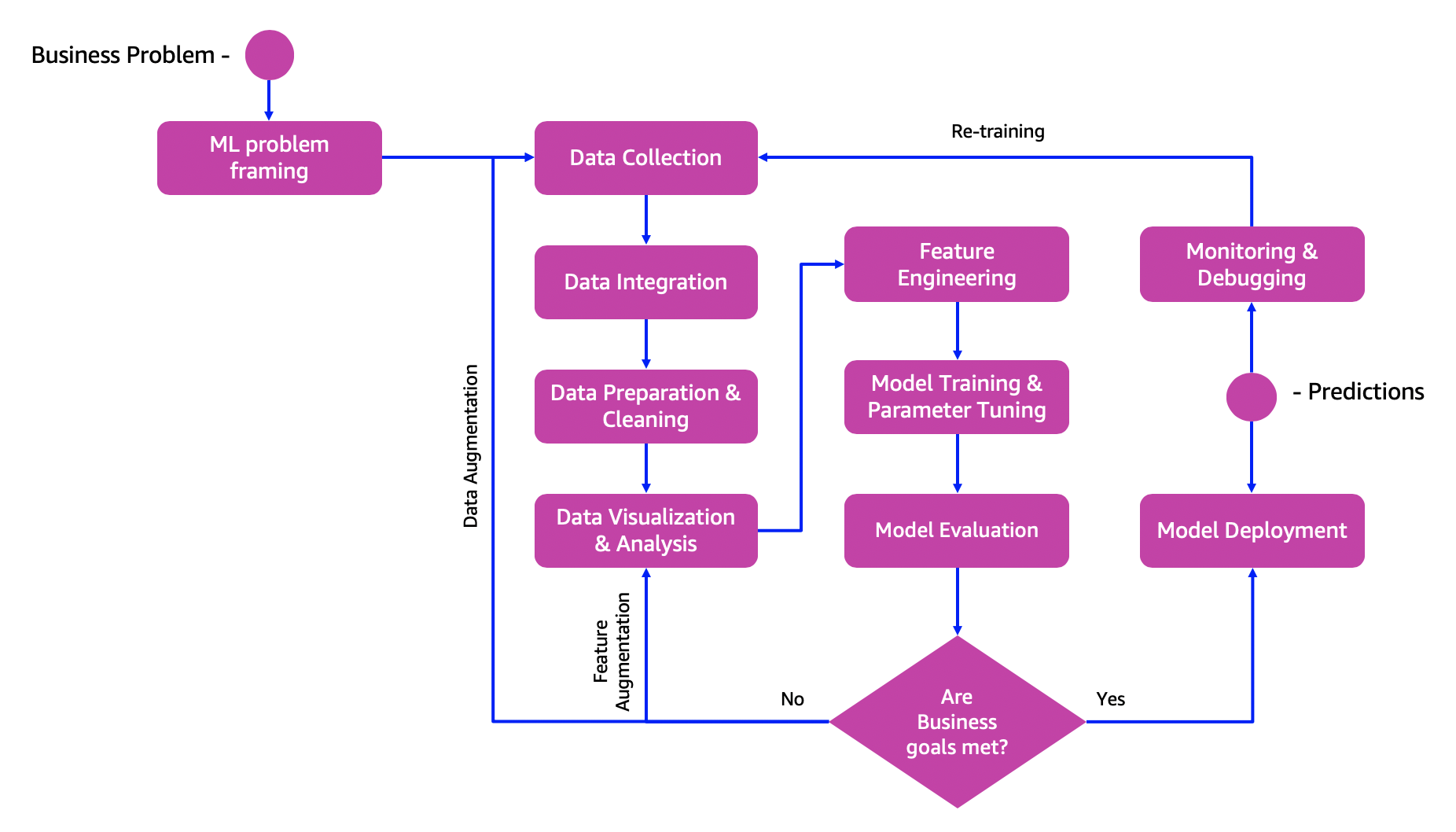In this workshop, you will go through the steps required to build a machine learning application on AWS using Amazon SageMaker.
You will learn how to start experimentation in the SageMaker Studio environment using a familiar Jupyter notebook experience, use Amazon SageMaker Processing Jobs for the preprocessing step, leverage Amazon SageMaker Training Jobs for the training step, deploy the model, and build an HTTP endpoint to serve inference requests. You will also learn how to automate the preprocessing and training step using Amazon SageMaker Pipelines.
The Machine Learning process is an iterative process consisting of several steps:
- Identifying a business problem and the related machine learning problem
- Data ingestion, integration and preparation
- Data visualization and analysis, feature engineering, model training and model evaluation
- Model deployment, model monitoring and debugging
These steps are usually repeated multiple times to better meet business goals after the source data changes or performance of the model drops, for example.
The following diagram shows how the process works:
After you deploy a model, you can integrate it with your own application to provide insights to the end users.
Amazon SageMaker is a fully-managed service that enables developers and data scientists to quickly and easily build, train, and deploy machine learning models at any scale.
Amazon SageMaker removes the complexity that holds back developer success with each of these steps; indeed, it includes modules that can be used together or independently to build, train, and deploy your machine learning models.
You will use the AI4I 2020 Predictive Maintenance Dataset from the UCI Machine Learning Repository. This synthetic dataset reflects real predictive maintenance data encountered in industry.
The dataset consists of 10,000 records and 14 features, representing some measurements that have been collected on the machinery, plus the indication of failure, if any. This is a basic dataset that oversimplifies the Predictive Maintenance task. However, it keeps this workshop easy to follow while being a good representative of the various steps of the machine learning workflow.
Your goal is to build a simple machine learning model that predicts whether a piece of machinery is going to fail (Predictive Maintenance).
Following is an excerpt from the dataset:
| UDI | Product ID | Type | Air temperature [K] | Process temperature [K] | ... | Machine failure |
|---|---|---|---|---|---|---|
| 1 | M14860 | M | 298.1 | 308.6 | ... | 0 |
| 2 | L47181 | L | 298.2 | 308.7 | ... | 0 |
| 3 | L47182 | L | 298.1 | 308.5 | ... | 0 |
| 51 | L47230 | L | 298.9 | 309.1 | ... | 1 |
The target variable, Machine failure, is a binary attributes, so it suggests the problem is a binary classification problem.
This diagram shows what you will be building in this workshop:

This workshops consists of eight modules:
- Module 0: Access the AWS Console.
- Module 1: Configure Amazon SageMaker Studio and clone the GitHub repository.
- Module 2: Use Amazon SageMaker Studio Notebooks and standard Python libraries to perform fast experimentation.
- Module 3: Perform data preprocessing and feature engineering using Amazon SageMaker Processing and SKLearn.
- Module 4: Train a binary classification model with the Amazon SageMaker open-source XGBoost container; the model will predict whether the machinery is going to fail.
- Module 5: Deploy the feature engineering and machine learning models as an inference pipeline using Amazon SageMaker hosting. Optionally, you can use Sagemaker Model Monitor to track data drift against the training data baseline.
- Module 6: Build a HTTP API using Amazon API Gateway and an AWS Lambda function to invoke the Amazon SageMaker endpoint for inference.
- Module 7: Use a web client to invoke the HTTP API and perform inference.
- Module 8: Use Amazon SageMaker Pipelines to orchestrate the model build workflow and store models in model registry.
Please follow the order of modules because the modules depend on the results from the previous modules.
If you are attending a End-to-End Machine Learning with Amazon SageMaker Workshop run by AWS, the AWS event facilitator provides you access to a temporary AWS account preconfigured for this workshop. Proceed to Module 01.
If you want to use your own AWS account, you'll have to execute some preliminary configuration steps as described in the Setup Guide.
⚠️ Running this workshop in your AWS account will incur costs. You will need to delete the resources you create to avoid incurring further costs after you have completed the workshop. Follow the clean up steps.
Dua, D. and Graff, C. (2019). UCI Machine Learning Repository [http://archive.ics.uci.edu/ml]. Irvine, CA: University of California, School of Information and Computer Science.
Giuseppe A. Porcelli - Principal ML Specialist Solutions Architect - Amazon Web Services
Antonio Duma - Senior Startup Solutions Architect - Amazon Web Services
Hasan Poonawala - Senior ML Specialist Solutions Architect - Amazon Web Services
Mehran Nikoo - Senior Digital Native Solutions Architect - Amazon Web Services
Bruno Pistone - AI/ML Specialist Solutions Architect - Amazon Web Services
Durga Sury - ML Solution Architect - Amazon Web Services
